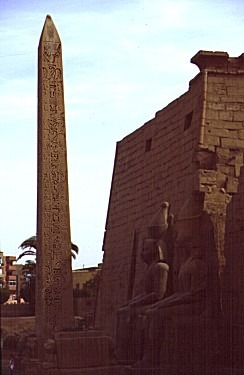
Modern name for the southern part of Thebes, the location of the temple of Amun Kamutef (called 'Ipet-resyt' in ancient Egyptian). The present temple was built by Amenhotep III and was expanded by various pharaohs after him, including Ramesses II. Alexander the Great initiated a restoration. The temple was linked to the temple of Karnak by a processional way lined with sphinxes. Once a year, during the Opet festival, the statue of the god Amun travelled between the two temples. Representations of this event were added to the temple of Luxor by Tutankhamun. In the Roman Period the temple was used for the cult of the divine emperor, and in Islamic times a mosque was built in part of the temple. Among the most important finds here is the discovery in 1989 of an underground cachette of statues, mainly from the 18th Dynasty. Further, in the great pylon of the temple have been found many blocks from constructions of Amenhotep IV/Akhenaten, dismantled after his death (so-called 'talatat' blocks). One of the two original obelisks in front of the temple is now in Paris.